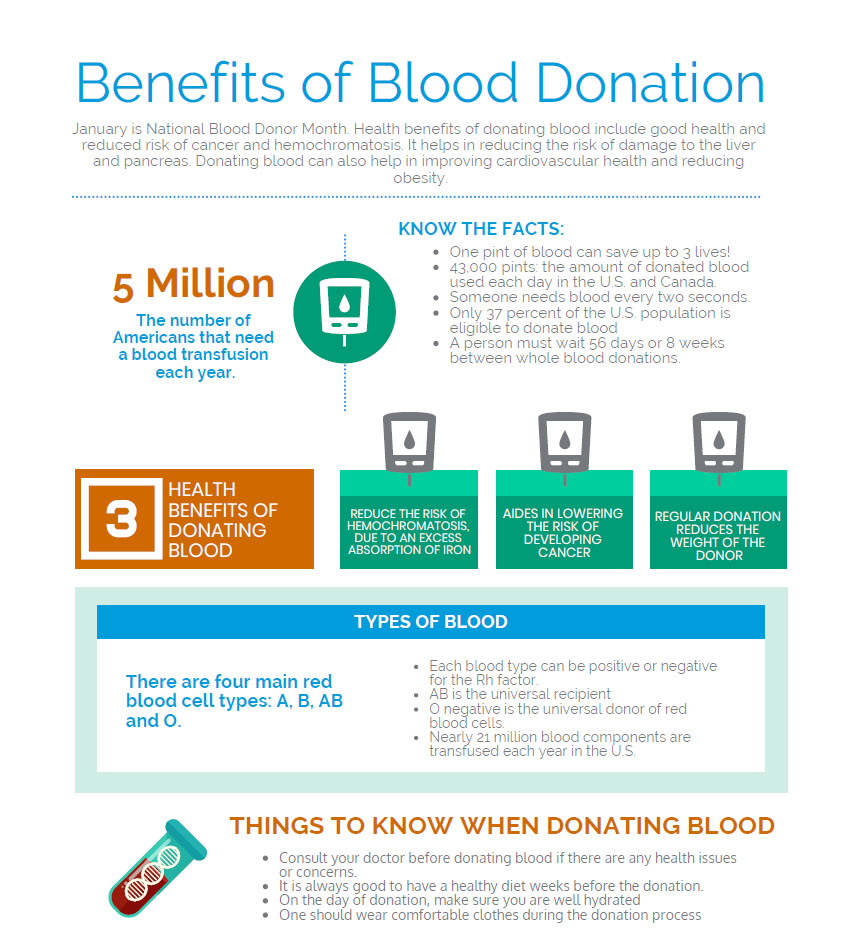

How Donating Helps
Every two seconds, someone in the United States needs blood. Donating blood can help:
- People who go through disasters or emergency situations
- People who lose blood during major surgeries
- People who have lost blood because of a gastrointestinal bleed
- Women who have serious complications during pregnancy or childbirth
- People with cancer or severe anemia sometimes caused by thalassemia or sickle cell disease
Before You Donate
If you think you want to donate blood, it’s important to make sure you meet the requirements and that you properly prepare.
First, you’ll need to find a blood bank or blood drive and make an appointment. Be sure to ask about any specific requirements for donors and what kinds of identification you need to bring with you. Tell the person on the phone if you have health concerns or problems or if you’ve recently traveled outside the country.
In the weeks before your appointment, you’ll want to make sure you’re getting a healthy amount of iron in your diet. Meat and seafood, as well as vegetables like spinach and sweet potatoes are good sources of iron. Certain breads, fruits, and other foods like beans and tofu can be good options too.
The day of your appointment, prepare yourself by drinking plenty of fluids and wearing comfortable clothes with sleeves that you can easily roll up above your elbow. Make sure you have a list of all the prescription and over-the-counter medications you’re taking, as well as the proper forms of ID.
The Four Steps of Blood Donation
The blood donation process can be broken down into four steps:
- Registration
- Medical history and mini-physical
- Donation
- Refreshments
While the whole process, from the time you get to the facility to the time you leave, can take about an hour, the actual donation itself may take as little as 8-10 minutes.
1. Registration
When you arrive at the blood bank or blood drive, you’ll sign in for your appointment and show your ID. Then you’ll complete paperwork that includes general information like your name, address, and phone number.
2. Medical history and mini-physical
Before you donate, an employee from the blood bank will ask you some confidential questions about your health and lifestyle. You’ll also get a short health exam or “mini-physical.” An employee will take your pulse, blood pressure, and temperature, and take a small sample of blood for testing.
3. Donation
When it’s time to donate, you’ll go into a donor room where you’ll lie down on a cot. A phlebotomist (an employee who draws blood) will clean your arm and insert a new, sterile needle into your vein. This takes just a few seconds, and it can feel like a quick pinch.
You’ll donate about 1 pint (one unit) of blood and the process should take less than 10 minutes (however, if you’re donating platelets, red cells, or plasma by apheresis, the process can take much longer — up to 2 hours). When you’re done, you’ll raise your donation arm and put a little bit of pressure on it, which helps your blood clot. Then they’ll put an adhesive strip on your arm.
4. Refreshments
After you’re finished, you’ll be given snacks and a drink to help your body get back to normal since you lost some fluids. You’ll want to sit and relax for at least 10 minutes to restore your strength and get some energy back before you leave.
Source: webmd.com
Benefits of Donating Blood infographic
View, download or share infographic below about the benefits of blood donation and things to know before donating blood


